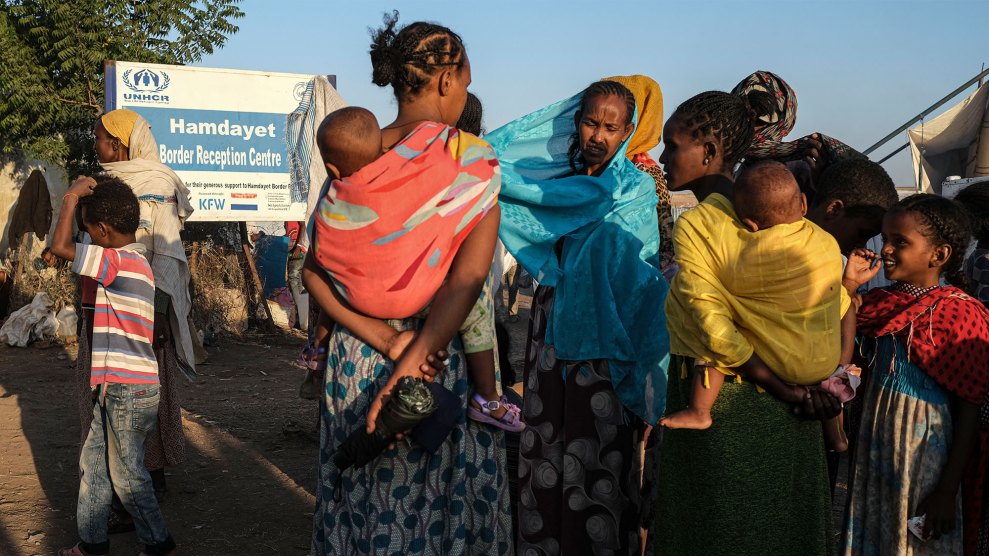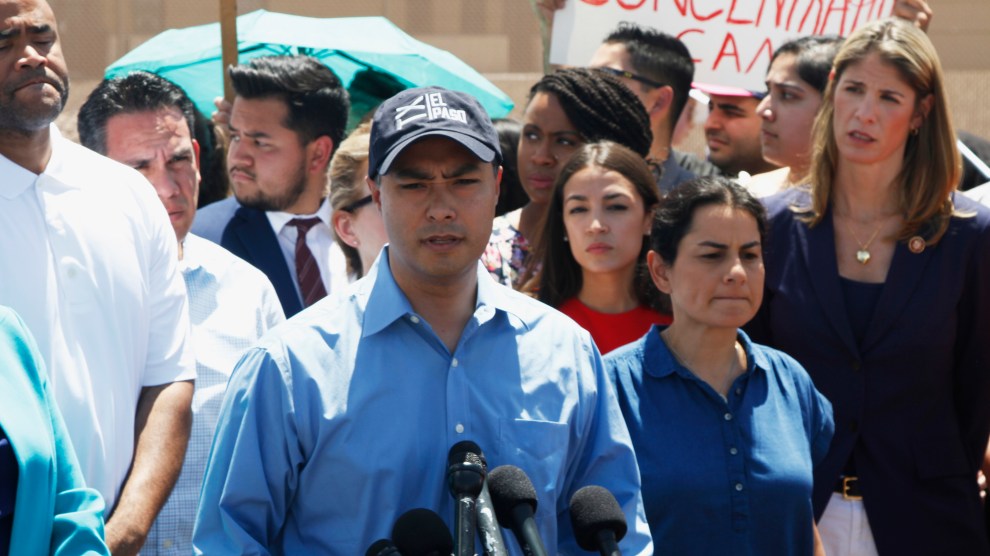
Young unaccompanied migrants sit inside a play pen in the Department of Homeland Security holding facility in Donna, Texas in March. Dario Lopez-Mills/Getty
“We have the experience and the expertise to process 125,000 refugees per year—easily,” Eskinder Negash told me this week. That’s eight times more than the historic low number the Biden administration recently said it’d allow into the country, before quickly backtracking in the face of pushback from allies and promising to announce a higher level of refugee admissions by May 15.
Much of the reason, it claimed, was that apparently it couldn’t walk and chew gum at the same time—since the Office of Refugee Resettlement (ORR), which is part of Health and Human Services, handles both the country’s refugee program and sheltering and placing unaccompanied migrant minors. As President Joe Biden explained last week, “The problem was that the refugee part was working on the crisis that ended up on the border with young people. We couldn’t do two things at once. But now we are going to increase the number.”
But, as Negash told me, that argument doesn’t really make that much sense. He would know: Now the president and CEO for the US Committee for Refugees and Immigrants, Negash ran ORR under President Obama, from 2009 to 2015—a tenure that saw what became known as the child migrant crisis of 2014, in which the number of unaccompanied minors at the border jumped almost 80 percent from the previous year, with more than 68,000 children and teens in US custody. Negash is also a refugee himself, and was welcomed to the US after fleeing Ethiopia in his 20s.
I spoke with him earlier this week about ORR’s division of labor, the differences between the 2014 crisis and what we’re seeing now, and what changes still need to be made when dealing with unaccompanied migrant children. Our conversation has been condensed and edited for clarity.
Could you start by sharing a bit about your own personal story and connection to working with refugees?
I was young when I left home and I went to another country the same way that someone from Guatemala, Honduras, or El Salvador does. It took me weeks to get to another country, I didn’t speak the language, I didn’t have any family members, and that’s how I ended up being a refugee in Sudan. And then from there, because of the US resettlement program, I came here 40 years ago. So for me, I think I continue to do this work because with those kids or any refugees regardless of where they came from, when I see them, what I see is myself. Their suffering and their journey is really personal for me; it’s not just a job. I came as a refugee as one of the lucky ones because many people don’t make it.
The Biden administration said that one of the reasons they couldn’t raise the refugee cap from a historically low one of 15,000 left by the previous administration was that they had to first deal with last month’s influx of unaccompanied minors at the border. But looking at 2014, for example, when there was a huge increase of unaccompanied minors at the border from the previous year, ORR handled that while keeping its refugee resettlement program operating as usual—the refugee caps for 2014 and 2015 didn’t change, they remained at 70,000.
So what is your response to the Biden administration’s reasoning for not increasing the refugee cap yet? And could you share insight into how ORR’s process works when it comes to managing both programs?
I think the difference between this crisis and when I was there is that the overseas refugee processing was fully staffed, fully funded. What’s different now is for the past four years, we have dismantled the refugee program overseas. In addition to that, we have COVID. I’m not trying to give excuses to the administration, I’m just being candid with you.
For unaccompanied minors, what we have now is different than when I was there, too. We had the influx then, yes, and we were struggling because we didn’t have enough capacity for beds. And to open a shelter you need to get a license issued by the state. So it takes a lot of time, sometimes up to six months in some places. That was a challenge for us because we didn’t have enough resources at that time. So I talked with the Obama administration so we could use military bases in Texas, Oklahoma, and California.
[Leading up to the increase of kids] this time, as you know, the number for unaccompanied minors was way, way down because of what the [Trump] administration decided, and then the refugee program was systematically dismantled—all the processing overseas, everything was really in shambles. So I think this administration’s intention is to bring in as many refugees as possible, but they realize also they have to go through a process. So just to focus on the comparison with the influx of unaccompanied children from 2014: We didn’t have COVID and we didn’t have the problem of losses to the refugee resettlement programs overseas.
To clarify, if someone works for ORR and their job is to work on the refugee resettlement side of things, they most likely stay on that side. And if somebody works for the unaccompanied children program, they do that work—it’s not like they would need to be responding to both things at once.
No, and they have a lot of people working there. You have the refugees section, where they work with each state and have a relationship with the state government. And it’s not just only about refugees—there are also asylees, and special visa holders, and the survivors of torture program. All of that is within the refugees section of ORR. So the refugee section is functioning. And then the unaccompanied minor section is doing its job. So no, they’re not doubling. I think we have the experience and the expertise to process 125,000 refugees per year, easily. I expect the Biden administration to increase the number of refugees by May 15 and then I expect them to make a decision by September on the 125,000 cap for 2022. The other thing is, as you know, the administration decided to withdraw from Afghanistan by September, so that means a number of special immigrant visa applicants—for Afghans who worked with the US government—will be coming in and we need to help them.
Having spent time working in the Obama administration during the influx of 2014, you knew what it was like to have to quickly respond to an increase of unaccompanied migrant children at the border. What do you think people need to understand about what is going on today?
I think people don’t understand how the system works and the division of labor between Health and Human Services and the Department of Homeland Security.
As you know, [DHS officials] have to transfer unaccompanied children within 72 hours to HHS. So DHS can project a certain number [of incoming unaccompanied children], but when that projection is wrong and it exceeds that number, that’s why we have the influx. It takes time to build that infrastructure for HHS to take them over. And then, we also have to do some checking; we can’t just simply release children to anybody who says, “Yeah, I will pick them up.” We have to vet the people. That’s why it takes sometimes between 30 days and 25 days: We have to contact the sponsor, and if necessary make a visit to make sure the kids are being released to a decent environment.
I think all of us—not just government, all of us—could actually help talking about the issue of how the process works. And I think that’s part of the challenge because sometimes the media focuses on DHS sites [run by the Border Patrol] and seeing those pictures and that will be the narrative. But HHS is different. There are close to 200 shelters around the country, and they are licensed by the state, the state’s health department, the fire department. There are ratios for how many case managers and clinicians per child; it’s really well organized, and I don’t think that gets enough credit.
What can this administration do to set up more permanent or long lasting solutions to this problem, so that in the next administration, or even the next couple years, we don’t find ourselves in the same place needing emergency influx shelters?
I think overall the government, regardless of which administration is in charge, needs to think about the reception of vulnerable children. We need to expand and maintain the number of licensed bed capacity to a minimum of 20,000 to 25,000 beds [in HHS facilities] at all times—that would be much better going forward. [Ed. note: HHS lists its bed capacity at 13,000, including in emergency shelters and state licensed facilities.] Unless the number exceeds 25,000, we should avoid the influx or emergency unlicensed shelters. We just have to accept the fact this is not an easy program to manage.
For post-release services, there also needs to be a follow up of, at a minimum, one year post release to make sure that the kids are fine. We also need to make sure that they get legal services. About 75 percent of kids with attorneys get asylum. So if you have an attorney, your chance of winning asylum is much higher. These are major solutions for future influxes.
More specifically, what should the Department of Homeland Security do?
I think we need to fund facilities that are humane for children. That’s really crucial. We can do better than what we are doing now, as a country. The first reception for children should not be in that kind of cage environment; that’s not really the way we want to process them. The other thing is, I think we need to engage back in their home countries with employment and education. We have to understand the level of violence and level of poverty are driving forces—we can’t deny that. You know we need to help work with the governments of these countries and civil society. I’ve been there many, many times and I can tell you there’s a lot we can do there. I don’t think anybody wants to leave their country. There is a reason people become refugees, there is a reason why they have to abandon everything they know and go to a country where they don’t speak the language or know the culture. I don’t think we should assume that just everybody wants to come to the US. That’s just not the case.
The number of unaccompanied minors coming to this country is very high, even when I was working at HHS under Obama. I think during my time we processed 135,000 children. So it’s not a small number. But you have to look at it also globally: Who are becoming refugees? Women and children. They’re the highest number, when you look at it globally and see who is moving from one area to another area. I know people focus only on the Central America, but there is a global migration of children, and nobody is really paying attention.

















